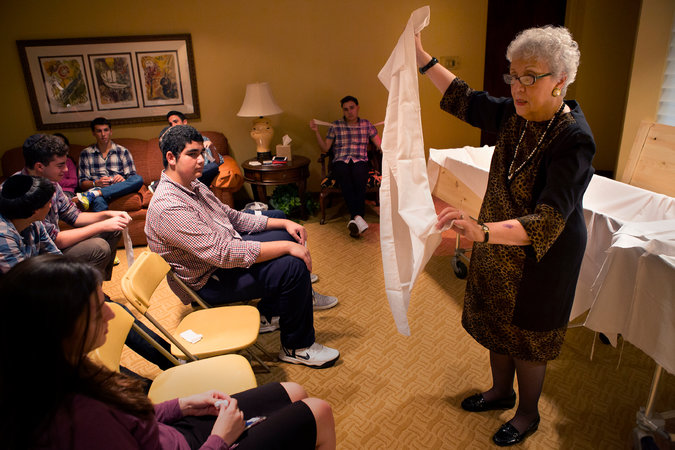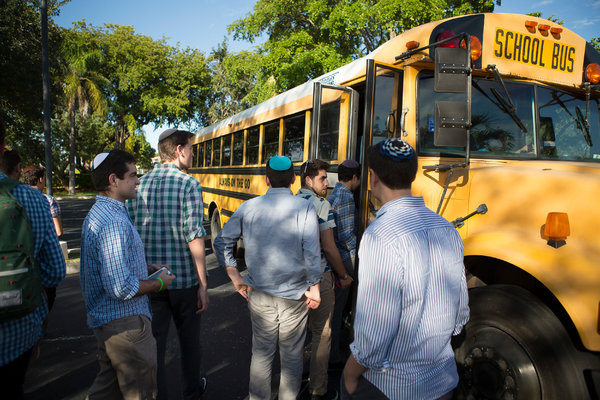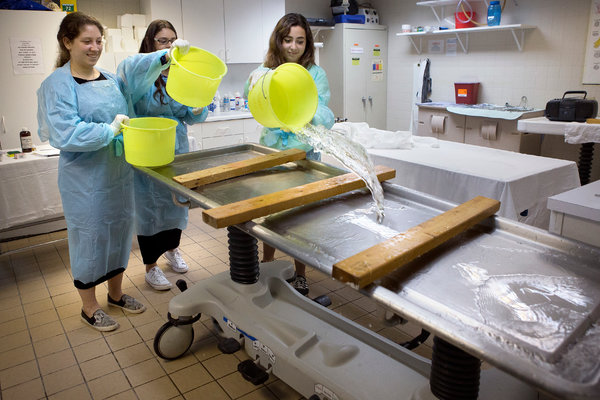
Two yellow buses pulled away from Yeshiva High School here with a couple of class periods still left and the 77 seniors aboard giddy with the words “field trip.” They texted. They posed for selfies. They sent up clouds of chatter about weekend plans.
Then, less than a half-hour later, they walked into a cool, tiled room at the Gutterman Warheit Memorial Chapel and stared at the pine coffins and the inclined metal table used for cleaning a corpse.
“I thought I was cool about death,” one girl whispered to a classmate. “But this ——”
“This” meant more than the contents of the room, which is used at the Jewish funeral home for the body-washing ritual called tahara. It connoted the entire mini-course that she, along with the rest of Yeshiva High School’s graduating class, is taking about the Judaic practices and traditions surrounding death, dying and grief.
Few subjects run more powerfully counter to an American teenager’s innate sense of immortality than a confrontation with the reality of life’s end. The study of death became more common at the college level with the publication of Elisabeth Kubler-Ross’s influential book, “On Death and Dying,” in 1969. But it is rare that the subject is discussed at the high school level, particularly with an approach that includes fairly explicit instruction in caring for a cadaver.

“As a senior, you’re thinking about going to college, and as a teenager you have this feeling of invincibility,” Daniel Feldan, 17, said the morning after the visit to the funeral home on Tuesday. “I’ve never had that other feeling — of mortality, that life might end soon.”
Bailey Frohlich, also 17, nodded at hearing her classmate’s words. “It’s given us a reality check,” she said. “For us, it’s usually about college and friends and extracurriculars. You don’t focus on the grittier things. But even if you don’t have a personal connection to death, thank God, it affects the whole community.”
The 10-hour, eight-session course, titled “The Final Journey: How JudaismDignifies the Final Passage,” aims for sensitivity even as it provokes a certain degree of shock. Besides going to the funeral home, where they received detailed explanations of washing and dressing a corpse, the students have classroom lessons on topics including the history of the Jewish burial societies known as chevra kadisha, the Talmudic foundations of end-of-life practices, and issues involving autopsy and organ donation.
“When we started the program, there was a lot of hesitation and curiosity at the same time,” said Rabbi Jonathan Kroll, 45, the yeshiva’s head of school. “Jewish tradition for dealing with burial and the process of tahara is not that well known. Even for a lot of well-educated Jews, the chevra kadisha is like a secret society. But once you start talking about the values involved or the practical aspects, there’s a fascination.”
The program at Yeshiva High School began with Rochel U. Berman, a 79-year-old author and a former nursing home worker who moved near the school 13 years ago. Her well-regarded book on Jewish burial rituals, “Dignity Beyond Death,” was published in 2005. Over the years she lived in South Florida and the New York metropolitan area, and she served as a chevra kadisha volunteer in both places, preparing the bodies of about 1,000 women and girls, from centenarians who simply wore out to an 18-month-old baby felled by cancer.
In broad ways, Jewish rituals around death and dying trace back to antiquity, and they have been central to Jewish continuity in the diaspora. The system of chevra kadisha emerged in Central Europe in the 16th century. Initially almost a social institution composed of the elite, chevra kadisha groups transformed over the centuries into an example of communal or congregational voluntarism.
An unlikely adopter of religious tradition, Ms. Berman grew up in Winnipeg, Manitoba, as the child of secular socialists. Her Jewish language, rather than the Hebrew of worship and Zionism, was the Yiddish of the Old World shtetl and the New World slum.
By the time Ms. Berman’s father died in 1985, she had grown observant. Even so, between the final kiss she planted on his forehead in his deathbed and the lowering of the coffin into the ground the next day, she had no idea what had been done with her father’s body.

“I didn’t know what I was missing, but I knew there was a hole there,” she recalled. “And the not-knowing made me even sadder.”
While living in New York, she and her husband, George Berman, both started volunteering in their Orthodox synagogue’s chevra kadisha, which has separate units for each gender. The processes of washing and purifying the body, of dressing it in a white linen shroud, of moving it into a plain wooden coffin filled her with a sense of communal purpose.
Not content with her own years as a volunteer or with her book, Ms. Berman resolved to reach young people as a way of imbuing the next generation with those Judaic values. “It’s a gift to give them, a part of the Jewish life cycle they didn’t know about,” she said. “And once they know it, they’ll be the ambassadors in sharing it.”
Rabbi Kroll assumed the leadership of Yeshiva High School in Boca Raton, Fla., three years ago. Coincidentally, it turned out that he, somewhat later than Ms. Berman, had belonged to the same synagogue and volunteered in the same chevra kadisha in New York’s Westchester County.
With $21,000 in grants from foundations and religious organizations, Ms. Berman devised a curriculum. Rabbi Kroll tested it last year with half of the seniors in the class of 2015.
“We had pushback,” he recalled, “but it wasn’t serious pushback. Several parents questioned the priority: ‘Why not use the time on something more pertinent, more relevant?’ My impression is that the pushback was about their own discomfort with mortality.”
As for the first batch of students, half of them reported on evaluation forms that, as a result of the course, they would consider being in a chevra kadisha. That response was more than sufficient for Rabbi Kroll to expand the program to this year’s entire senior class. Among the 78 students, he said, only three have had an immediate family member die. (One of those three was excused from the funeral home trip.)
Even those like Maya Borzak, 18, whose grandfather served in a chevra kadisha, found there was plenty to learn. In fact, the funeral home visit occurred just five days before the unveiling of that grandfather’s headstone, which in Jewish tradition takes place after a year of mourning.
“I always knew that, in general, it’s important to have a Jewish identity, that you’re born a Jew and you need to die a Jew,” Maya said. “You have a circumcision if you’re a boy, you have baby-naming if you’re a girl, and then, at the end, everyone is buried in the same way.”
“Now I know more than the sources for the processes and rituals,” she said. “I know the dignity that is supposed to be provided for everyone who dies. It’s the great equalizer. We’re all in this together.”
Complete Article HERE!
